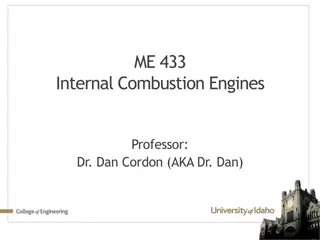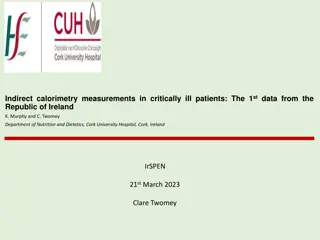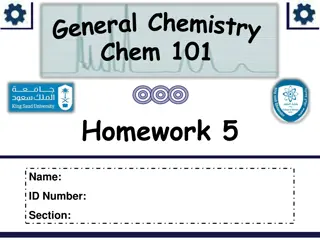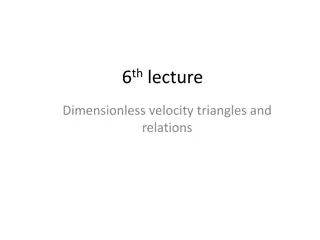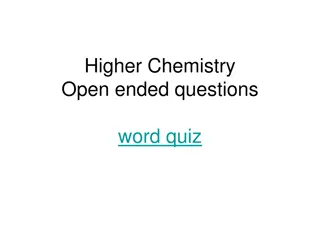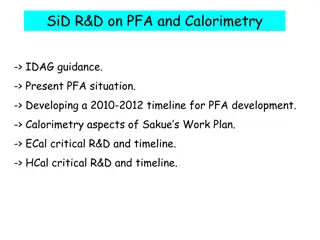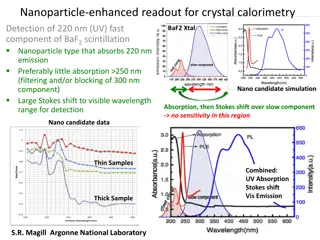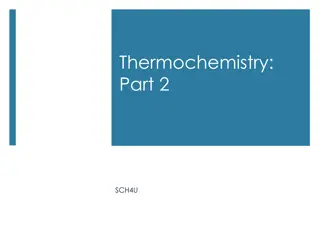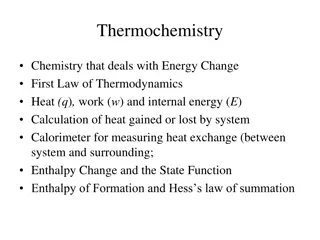Understanding Calorimetry and Enthalpy Changes in Chemistry
This content explores various concepts related to calorimetry, enthalpy changes, and Hess's Law in the field of chemistry. It covers topics such as energy released in combustion reactions, heat capacity, phase changes, and the application of Hess's Law in determining enthalpy changes. Enthalpy values for phase changes, energy conversion calculations, and comparisons between combustion energies of different fuels are discussed in detail.
Download Presentation

Please find below an Image/Link to download the presentation.
The content on the website is provided AS IS for your information and personal use only. It may not be sold, licensed, or shared on other websites without obtaining consent from the author. Download presentation by click this link. If you encounter any issues during the download, it is possible that the publisher has removed the file from their server.
E N D
Presentation Transcript
Constant-Pressure Calorimetry III A 0.5269 g of octane is placed in a bomb calorimeter known to have a heat capacity of 11.3 kJ/oC. The octane, a component of gasoline, is ignited in the presence of excess oxygen. The temperature is increased by 2.25o C. What is the energy released per mole?
Enthalpy for phase changes There are constant values for the enthalpy of a phase change. The energy required to go from solid to liquid is called the heat of fusion (Hfus). The energy required to go from liquid to gas is called heat of vaporization (Hvap). q = H n For heating a substance, q = nC T or q = mc T
Quantitative Aspects of Changes of State The Heating-Cooling Curve.
Problem How much heat is required to heat 3.65 mol of ice at 15o C to steam at 115o C? Hfus = 6010 J/mol Hvap = 40,700 J/mol Cice = 38.09 Cwater = 75.3 Csteam = 36.8 (heat to melting-15 to 0) (heat to melt) (heat to boiling 0 to 100) (heat to boil off) (heat to 100 to 115) q = 3.65 (38.09) 15 + 3.65(6010) +3.65(75.3)100 + 3.65(40700) + 3.65(36.8)15 q = 202 kJ
It has been suggested that hydrogen gas obtained by the decomposition of water might be a substitute for natural gas (principally methane). To compare the energies of combustion of these fuels, the following experiment was carried out using a bomb calorimeter with a heat capacity of 11.3 kJ/oC. When 1.50 g sample of methane gas burned with excess oxygen in the calorimeter, the temperature increased by 7.3 oC. When a 1.15g sample of hydrogen gas was burned with excess oxygen, the temperature increase was 14.3 oC. Calculate the energy of combustion (per gram and per mole) for hydrogen and methane.
Hesss Law Since enthalpy is a state function, the change in enthalpy in going from some initial state to some final state is independent of the pathway. In going from one particular set of reactants to a particular set of products, the change in enthalpy is the same whether the reaction takes place in one step or a series of steps. This is known as Hess s Law
Characteristics of Enthalpy Changes Two important characteristics of H for a reaction. If a reaction is reversed, the sign of H is also reversed The magnitude of H is directly proportional to the quantities of reactants and products in a reaction. If the coefficients in a balanced reaction are multiplied by an integer, the value of H is multiplied by the same integer.
Hesss Law I. Two forms of carbon are graphite, the soft, black, slippery material used in lead pencils and as a lubricant for locks, and diamond, the brilliant, hard gemstone. Using the enthalpies of combustion for graphite (-394 kJ/mol) and diamond (-396 kJ/mol), calculate H for the conversion of graphite to diamond: Cgraphite(s) Cdiamond(s)
Diborane (B2H6) is a highly reactive boron hydride, which was once considered as a possible rocket fuel for the US space program. Calculate H for the synthesis of diborane from its elements, according to the equation Reaction 2B(s) + 3H2(g) B2H6(g) using the following data H 2B(s) + 3/2O2(g) B2O3(s) B2H6(g) + 3O2(g) B2O3(s) + 3H2O(g) -2035 kJ H2(g) + 1/2O2 H2O(l) H2O(l) H2O(g) -1273 kJ -286 kJ +44 kJ
Using Hesss Law Work backwards from the required reaction, using the reactant and products to decide how to manipulate the other given reactions at your disposal. Reverse any reactions as needed to give the required reactants and products, and then multiply reactions to give the correct number of reactants and products.
More Practice Calculate the enthalpy change for the following ClF(g) + F2(g) ClF3(g) Given the following reactions 2ClF(g) + O2(g) Cl2O(g) + F2O(g) H= 167.4 kJ 2ClF3(g)+2O2(g) Cl2O(g) +3F2O(g) H= 341.4 kJ 2F2(g)+O2(g) 2F2O(g) H= -43.4 kJ
Standard Enthalpy of Formation and Standard States Because enthalpy is a state function, H may be calculated more than one way. The standard enthalpy of formation ( Hfo) of a compound is defined as the change in enthalpy that accompanies the formation of one mole of a compound from its elements with all substances in their standard states. Standard state is indicated by symbol, o. A standard state is a reference state for a specific substance defined according to a set of conventional definitions
Standard state of a compound The standard state of a gaseous substance is a pressure of exactly 1 atmosphere. For a pure substance in a condensed state (liquid or solid), the standard state is the pure liquid or solid. For a substance present in a solution, the standard state is a concentration of exactly 1 M.
Standard State of an Element The standard state of an element is the form in which the element exists under conditions of 1 atmosphere and 25 oC. (The standard state for oxygen is O2(g) at a pressure of 1 atmosphere; the standard state for sodium is Na(s); the standard state for mercury is Hg(l), and so on.) For an element in its standard state, Hfo= 0, always! Values may be found in Appendix 4 of your book.
Standard Enthalpy of Reaction. The standard heat of reaction ( Hrxno is the sum of the standard heats (enthalpies) of formation of the products minus the sum of the standard heats of formation of the reactants. Hrxno = m Hfo(products) - n Hfo(reactants) Elements are not included in the calculations because their value is equal to zero
Standard enthalpy of formation 4NH3(g) + 7O2(g) 4NO2(g) + 6H2O(l) Using the standard enthalpies of formation listed in Table, calculate the standard enthalpy change for the overall reaction that occurs when ammonia is burned in air to form nitrogen dioxide and water. This is the first step in the manufacture of nitric acid. Standard Enthalpy of Formation Hf (kJ/mol) NH3(g) NO2 (g) H2O(l) Al2O3(s) Fe2O3(s) CO2 CH3OH(l) C8H18(l) -46 34 -286 -1676 -826 -394 -239 -269


